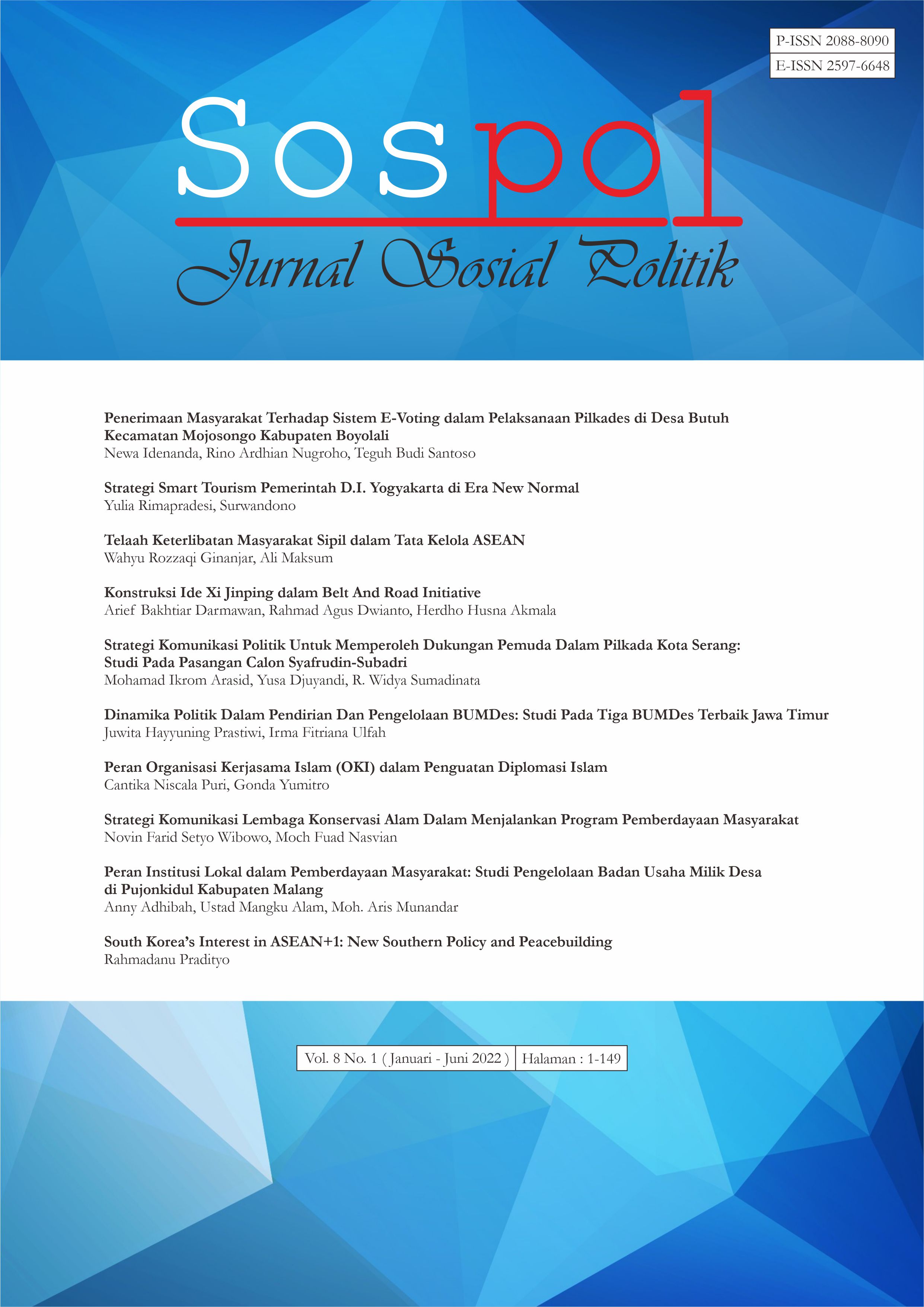Penerimaan Masyarakat Terhadap Sistem E-Voting dalam Pelaksanaan Pilkades di Desa Butuh Kecamatan Mojosongo Kabupaten Boyolali
DOI:
https://doi.org/10.22219/jurnalsospol.v8i1.14159Keywords:
e-voting, Penerimaan Masyarakat, Pilkades, Unified Model of Electronic Government Adoption (UMEGA), SEM-PLSAbstract
Electronic voting (e-voting) is the use of technology in general election, that can overcome the usually occur in conventional voting. This research aims to determine what factors influence public acceptance when using the e-voting system in the implementation of Pilkades in Butuh Village, Mojosongo Sub-Disctrict, Boyolali Regency by using Unified Model of Electronic Government Adoption (UMEGA). This study used quantitative methods and data collection using questionnaires. Sampling techniques using accidental sampling. The data analysis techniques used Partial Least Squares with the Smart.PLS 3.0 application. The result showed performance expectancy, effort expectancy, social influence, and attitude had a positive and significant effect on the behavioral intention of e-voting system users. While facilitating conditions and perceived risk are shown to have no effect on the behavioral intention of e-voting system users. And it was also found that the influence of user attitude successfully moderated the effect of performance expectancy, effort expectancy, and social influence on the behavioral intention of e-voting system users.
Downloads
References
Abdillah, W., & Hartono, J. (2015). Partial Least Square ( PLS)- Alterantif Structural Equation Modeling (SEM) dalam Penelitian Bisnis. Yogyakarta.
Achieng, M., & Ruhode, E. (2013). The Adoption and Challenges of Electronic Voting Technologies Within the South African Context. International Journal of Managing Information Technology, 5(4), 1–12. https://doi.org/10.5121/ijmit.2013.5401
Adeshina, S. A., & Ojo, A. (2020). Factors for e-voting adoption - analysis of general elections in Nigeria. Government Information Quarterly, 37(3), 0–1. https://doi.org/10.1016/j.giq.2017.09.006
Apriani, T., Hamudy, M. I. A., Rifki, M. S., & Hadi, A. S. (2018). E-voting in the Village Head Election in Batanghari and Kabupaten Bogor Regencies. Jurnal Bina Praja, 10(2), 317–326. https://doi.org/10.21787/jbp.10.2018.317-326
Aprudi, S., & Saputra, Y. (n.d.). Kajian Penerimaan Penerapan Sistem E-Voting Pada Pilkades Di Kecamatan Megang Sakti Dengan Pendekatan Technology Acceptance Model ( TAM ). 203–208.
Arthur, J. K., & Adu-Manu, K. S. (2014). A trustworthy architectural framework for the administration of e-voting: the case of Ghana. Int J Comput Sci Issues (IJCSI), 11(3), 97–102.
Chauhan, S., Jaiswal, M., & Kar, A. K. (2018). The acceptance of electronic voting machines in India: A UTAUT approach. Electronic Government, 14(3), 255–275. https://doi.org/10.1504/EG.2018.093427
Darmawan, I., & Nurhandjati, N. (2016). Why Adopt E-voting? Study on Village Leader Elections in Musi Rawas, South Sumatera. Jurnal Politik, 1(2), 5–29. https://doi.org/10.7454/jp.v1i2.16
Dwivedi, Y. K., Rana, N. P., Janssen, M., Lal, B., Williams, M. D., & Clement, M. (2017). An empirical validation of a unified model of electronic government adoption (UMEGA). Government Information Quarterly, 34(2), 211–230. https://doi.org/10.1016/j.giq.2017.03.001
Ghozali, I. (2014). Structural Equation Modeling: Metode Alternatif dengan Partial Least Squares (PLS). Badan Penerbit Universitas Diponegoro.
Gibson, J. P., Krimmer, R., Teague, V., & Pomares, J. (2016). A review of E-voting: the past, present and future. Annales Des Telecommunications/Annals of Telecommunications, 71(7–8), 279–286. https://doi.org/10.1007/s12243-016-0525-8
Habibi, M. (2018). Dinamika Implementasi E-Voting di Berbagai Negara. 1–23. https://doi.org/10.31227/osf.io/bu2ax
Hair, J. F., Hult, G. T. M., & Ringle, C. M. (n.d.). A Primer on Partial Least Squares Structural Equation Modeling ( PLS-SEM ).
Halderman, J., & Teague, V. (2015). The new south wales ivote systevem: Security failures and verification flaws in a live online election. E-Voting and Identity, 35–53.
Hapsara, M., Imran, A., & Turner, T. (2017). E-voting in developing countries: Current landscape and future research agenda. In Lecture Notes in Computer Science (including subseries Lecture Notes in Artificial Intelligence and Lecture Notes in Bioinformatics): Vol. 10141 LNCS. Springer International Publishing. https://doi.org/10.1007/978-3-319-52240-1_3
Hardjaloka, L., & Simarmata, V. M. (2016). E-Voting: Kebutuhan vs. Kesiapan (Menyongsong) E-Demokrasi. Jurnal Konstitusi, 8(4), 579–604.
Heiberg, S., Parsovs, A., & Willemson, J. (2015). Log analysis of estonian internet voting 2013–2014. In Lecture Notes in Computer Science (including subseries Lecture Notes in Artificial Intelligence and Lecture Notes in Bioinformatics) (Vol. 9269, pp. 19–34). Springer. https://doi.org/10.1007/978-3-319-22270-7_2
Ismarmiaty, M. (2017). Analisis Model Penerimaan Dan Penggunaan Sistem Informasi Website Padamu Negeri Oleh Pengguna Menggunakan Model Unified Theory Of Acceptance And Use Of Technology (Utaut). Jurnal Matrik, 16(1), 77. https://doi.org/10.30812/matrik.v16i1.13
Iswahyudi, M. (2017). Determinan Sikap Pemerintah Desa dalam Menggunakan Sistem E-village Budgeting. Jurnal Ilmiah Administrasi Publik, 3(2), 102–108. https://doi.org/10.21776/ub.jiap.2017.003.02.3
Kusuma, D. H., & Puspaningsih, A. (2016). Model Penerimaan User Dalam Implementasi SAP (Systems Application and Product) dengan Menggunakan Model UTAUT. Jurnal Aplikasi Bisnis, 15(9), 1799–1822. https://doi.org/10.20885/jabis.vol15.iss9.art3
Lubis, M., Kartiwi, M., & Durachman, Y. (2017). Assessing privacy and readiness of electronic voting system in Indonesia. 2017 5th International Conference on Cyber and IT Service Management, CITSM 2017, August. https://doi.org/10.1109/CITSM.2017.8089242
Maaten, E. (2004). Towards remote e-voting : Estonian case. Proceedings of the 1st Conference on Electronic Voting, 83–90.
Madise, Ü., & Martens, T. (2008). E-voting in Estonia 2005. The first practice of country-wide binding Internet voting in the world. Proceedings Electronic Voting 2008, 15–26.
Morris, M. G., Hall, M., Davis, G. B., Davis, F. D., & Walton, S. M. (2003). arterly. 27(3), 425–478.
Moynihan, D. P. (2004). Building secure elections: E-voting, security, and systems theory. Public Administration Review, 64(5), 515–528. https://doi.org/10.1111/j.1540-6210.2004.00400.x
Oostveen, A. M., & van den Besselaar, P. (2004). Internetne glasovalne tehnologije in držvljanska participacija z vidika uporabnikov. Javnost, 11(1), 61–78. https://doi.org/10.1080/13183222.2004.11008847
Pinault, T., & Courtade, P. (2012). E-voting at expatriates’ MPs elections in France. In Lecture Notes in Informatics (LNI), Proceedings - Series of the Gesellschaft fur Informatik (GI): Vol. P-205 (Issue February, pp. 190–196).
Ridlo, M. (2018). Pilkades E-Voting Pemalang Berujung Demo Besar, Ada yng Curang?
Serdult, U., Germann, M., Mendez, F., Portenier, A., & Wellig, C. (2015). Fifteen years of internet voting in Switzerland [history, governance and use]. 2015 Second International Conference on Edemocracy & Egovernment (ICEDEG)., 126–132.
Setiawan, A. (2017). Pengaruh Penerapan Remote Electronic Voting System (REVS) Terhadap Tingkat Partisipasi Pemilih Menggunakan Model UTAUT. JTT (Jurnal Teknologi Terapan), 3(1), 1–6. https://doi.org/10.31884/jtt.v3i1.1
Shara, P. V., & Widodo, T. (2018). Penerapan Model Unified Theory of Acceptance and Use of Technology ( Utaut ) Dalam Menganalisis Penggunaaan. XX, 70–83.
Springall, D., Finkenauer, T., Durumeric, Z., Kitcat, J., Hursti, H., MacAlpine, M., & Halderman, J. (2014). Security analysis of the Estonian internet voting system. 2014 ACM SIGSAC Conference on Computer and Communications Security, 703–715.
Sugiyono. (2009). Metode Penelitian Kuantitatif, Kualitatif, dan R&D. Alfabeta.
Suparyati, S. (2019). Analisis Perilaku Pengguna E-Kinerja Menggunakan Model UTAUT. Kilat, 8(2), 208–218. https://doi.org/10.33322/kilat.v8i2.588
Tokdemir, G., Paçin, Y., Kurfal, M., & Arifo, A. (2017). Computers in Human Behavior Adoption of e-government services in Turkey. 66, 168–178. https://doi.org/10.1016/j.chb.2016.09.041
Vankatesh; Viswanath; G.Morris; Michael;B.Davis; (2003). User Acceptance of Information Technology: Toward a Unified View. MIS Quarterly, 27(3), 425–478.
Verkijika, S. F., & De Wet, L. (2018). E-government adoption in sub-Saharan Africa. Electronic Commerce Research and Applications, 30(May), 83–93. https://doi.org/10.1016/j.elerap.2018.05.012
Verkijika, S. F., & Wet, L. De. (2018). Electronic Commerce Research and Applications E-government adoption in sub-Saharan Africa. Electronic Commerce Research and Applications, 30(May), 83–93. https://doi.org/10.1016/j.elerap.2018.05.012
Widodo, T. (2019). Kecewa Hasil Pilkades, Warga Geruduk Kecamatan. Jawa Pos Radar Solo.
Wiranata, J. N. M. Y. N. F. A. Z. A. M. S. N. A. (2018). E-Voting di Bantaeng: Mengubah Mindset Masyarakat (J. N. A. Zulfikar (ed.)). Penerbit De La Macca.
Downloads
Published
How to Cite
Issue
Section
License
Copyright (c) 2022 Newa Idenanda, Rino Ardhian Nugroho

This work is licensed under a Creative Commons Attribution-ShareAlike 4.0 International License.
Authors who publish with this journal agree to the following terms:
- Authors retain copyright and grant the journal right of first publication with the work simultaneously licensed under a Creative Commons Attribution-ShareAlike 4.0 International License that allows others to share the work with an acknowledgement of the work's authorship and initial publication in this journal.
- Authors are able to enter into separate, additional contractual arrangements for the non-exclusive distribution of the journal's published version of the work (e.g., post it to an institutional repository or publish it in a book), with an acknowledgement of its initial publication in this journal.
- Authors are permitted and encouraged to post their work online (e.g., in institutional repositories or on their website) prior to and during the submission process, as it can lead to productive exchanges, as well as earlier and greater citation of published work (See The Effect of Open Access).

This work is licensed under a Creative Commons Attribution-ShareAlike 4.0 International License.



















